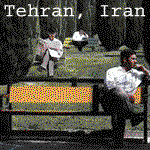Chicago Illinois Cabrini Green
 20 August 2007
20 August 2007Cabrini Green became legendary in the United States first in the 1940s when it was mostly occupied by Italian immigrants and then later on in the 1970s and 80s when the housing project was almost completely occupied by African Americans.
 JR is fighting for the survival of Cabrini Green and is opposed to the new development
JR is fighting for the survival of Cabrini Green and is opposed to the new developmentThe city is trying to develop something completely different; smaller apartment blocks that will be divided into apartments for subsidised rental by poor people (30 per cent), those for limited-price sale to middle-income buyers (20 per cent) and apartments for sale at whatever prices the market will bear (50 per cent).
Today, about 5,000 residents remain in the area, plus an unknown number of squatters occupying 'vacant' apartments that are slated for demolition. This has not necessarily improved former residents' lives. Many have joined a lawsuit alleging that they were hastily forced into other slums, and denied social services to get a leg up in society.
 Kelvin hopes to be one of the few residents to own an apartment in the new Cabrini Green
Kelvin hopes to be one of the few residents to own an apartment in the new Cabrini GreenD. Bradford Hunt, a professor of Social Sciences at Roosevelt University, explains the history of public housing in the US. While William Little, the director of development at the Chicago Housing Authority, tells us about the new plans the administration has to solve the housing issue and the future of the poor.
At the same time we will witness the end of a community, the dreadful living conditions of families evicted from the complex, and the imminent arrival of the big-chain stores and a new white upper class that will transform the area.
 George Robbins used to have his barber shop in Cabrini Green
George Robbins used to have his barber shop in Cabrini GreenOther former residents tell us their story: Clara Brooms, who goes back to church at Cabrini, shares her memories of the Cabrini that used to be; George Robbins, who had his barber shop at Cleveland and Division Streets and would like it to be back there; and H20, a rapper who transformed the housing project into a brand called 'Cabrini Heat'.
Part 1
Part 2
Labels: United States














0 Comments:
Post a Comment
<< Home